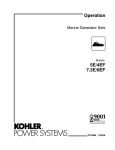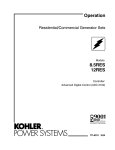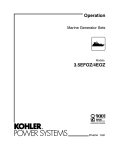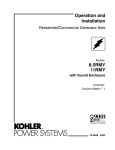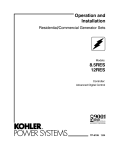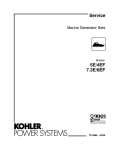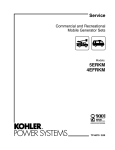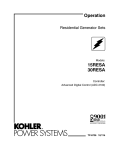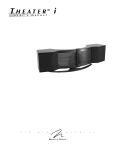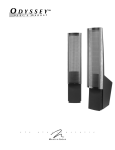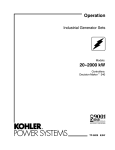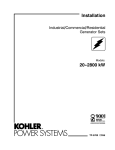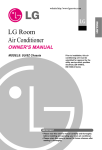Download Installation Manual, 7ER (TP-6034)
Transcript
Installation Commercial Mobile Generator Sets Model: 7ER TP-6034 10/02a Table of Contents Safety Precautions and Instructions . . . . . . . . . . . . . . . . . . . . . . . . . . . . . . . . . . . . . . . . . . . . . . . . . . . . . . . . . . . . I Section 1. Introduction . . . . . . . . . . . . . . . . . . . . . . . . . . . . . . . . . . . . . . . . . . . . . . . . . . . . . . . . . . . . . . . . . . . . . . 1.1 Installation Standards . . . . . . . . . . . . . . . . . . . . . . . . . . . . . . . . . . . . . . . . . . . . . . . . . . 1.2 Generator Set Specifications . . . . . . . . . . . . . . . . . . . . . . . . . . . . . . . . . . . . . . . . . . . . 1.3 Generator Set Operation . . . . . . . . . . . . . . . . . . . . . . . . . . . . . . . . . . . . . . . . . . . . . . . 1 1 1 1 Section 2. Location and Mounting . . . . . . . . . . . . . . . . . . . . . . . . . . . . . . . . . . . . . . . . . . . . . . . . . . . . . . . . . . 2.1 General Considerations . . . . . . . . . . . . . . . . . . . . . . . . . . . . . . . . . . . . . . . . . . . . . . . . 2.2 Location . . . . . . . . . . . . . . . . . . . . . . . . . . . . . . . . . . . . . . . . . . . . . . . . . . . . . . . . . . . . . 2.3 Vehicle-Floor Mounting . . . . . . . . . . . . . . . . . . . . . . . . . . . . . . . . . . . . . . . . . . . . . . . . . 2.4 Extended-Shaft Mounting . . . . . . . . . . . . . . . . . . . . . . . . . . . . . . . . . . . . . . . . . . . . . . . 3 3 3 3 4 Section 3. Cooling System . . . . . . . . . . . . . . . . . . . . . . . . . . . . . . . . . . . . . . . . . . . . . . . . . . . . . . . . . . . . . . . . . 3.1 Air Requirements . . . . . . . . . . . . . . . . . . . . . . . . . . . . . . . . . . . . . . . . . . . . . . . . . . . . . . 3.2 High Water Temperature Switch . . . . . . . . . . . . . . . . . . . . . . . . . . . . . . . . . . . . . . . . . 5 5 5 Section 4. Exhaust System . . . . . . . . . . . . . . . . . . . . . . . . . . . . . . . . . . . . . . . . . . . . . . . . . . . . . . . . . . . . . . . . . 4.1 Planning . . . . . . . . . . . . . . . . . . . . . . . . . . . . . . . . . . . . . . . . . . . . . . . . . . . . . . . . . . . . . 4.2 Clearance Requirements . . . . . . . . . . . . . . . . . . . . . . . . . . . . . . . . . . . . . . . . . . . . . . . 4.3 Exhaust Piping, If Used . . . . . . . . . . . . . . . . . . . . . . . . . . . . . . . . . . . . . . . . . . . . . . . . 7 8 8 8 Section 5. Fuel System . . . . . . . . . . . . . . . . . . . . . . . . . . . . . . . . . . . . . . . . . . . . . . . . . . . . . . . . . . . . . . . . . . . . 9 5.1 Fuel Tank . . . . . . . . . . . . . . . . . . . . . . . . . . . . . . . . . . . . . . . . . . . . . . . . . . . . . . . . . . . . 9 5.2 Fuel Lines . . . . . . . . . . . . . . . . . . . . . . . . . . . . . . . . . . . . . . . . . . . . . . . . . . . . . . . . . . . . 10 5.3 Fuel Pump Lift and Fuel Consumption . . . . . . . . . . . . . . . . . . . . . . . . . . . . . . . . . . . . 10 5.4 Fuel Filters or Strainers . . . . . . . . . . . . . . . . . . . . . . . . . . . . . . . . . . . . . . . . . . . . . . . . . 10 Section 6. Electrical System . . . . . . . . . . . . . . . . . . . . . . . . . . . . . . . . . . . . . . . . . . . . . . . . . . . . . . . . . . . . . . . . 6.1 Electrical Connections . . . . . . . . . . . . . . . . . . . . . . . . . . . . . . . . . . . . . . . . . . . . . . . . . 6.2 AC Load Lead Connections . . . . . . . . . . . . . . . . . . . . . . . . . . . . . . . . . . . . . . . . . . . . . 6.3 Circuit Protection . . . . . . . . . . . . . . . . . . . . . . . . . . . . . . . . . . . . . . . . . . . . . . . . . . . . . . 6.3.1 Circuit Breaker Considerations . . . . . . . . . . . . . . . . . . . . . . . . . . . . . . . . . . 6.3.2 Circuit Breaker Installation . . . . . . . . . . . . . . . . . . . . . . . . . . . . . . . . . . . . . . 6.4 Battery and Connections . . . . . . . . . . . . . . . . . . . . . . . . . . . . . . . . . . . . . . . . . . . . . . . 6.5 Remote Switch Connection . . . . . . . . . . . . . . . . . . . . . . . . . . . . . . . . . . . . . . . . . . . . . 11 11 11 13 13 14 15 16 Section 7. Installation Drawing . . . . . . . . . . . . . . . . . . . . . . . . . . . . . . . . . . . . . . . . . . . . . . . . . . . . . . . . . . . . . 17 Section 8. Reconnection/Adjustments . . . . . . . . . . . . . . . . . . . . . . . . . . . . . . . . . . . . . . . . . . . . . . . . . . . . . . 19 8.1 Four-Lead Reconnection . . . . . . . . . . . . . . . . . . . . . . . . . . . . . . . . . . . . . . . . . . . . . . . 19 8.2 Voltage Regulation Adjustment . . . . . . . . . . . . . . . . . . . . . . . . . . . . . . . . . . . . . . . . . . 21 Appendix A. Generator Selection and Wattage Requirements . . . . . . . . . . . . . . . . . . . . . . . . . . . . . . . . . A-1 Appendix B. Glossary of Abbreviations . . . . . . . . . . . . . . . . . . . . . . . . . . . . . . . . . . . . . . . . . . . . . . . . . . . . . A-2 TP-6034 10/02 Table of Contents Notes Table of Contents TP-6034 10/02 Safety Precautions and Instructions IMPORTANT SAFETY INSTRUCTIONS. Electromechanical equipment, including generator sets, transfer switches, switchgear, and accessories, can cause bodily harm and pose life-threatening danger when improperly installed, operated, or maintained. To prevent accidents be aware of potential dangers and act safely. Read and follow all safety precautions and instructions. SAVE THESE INSTRUCTIONS. This manual has several types of safety precautions and instructions: Danger, Warning, Caution, and Notice. DANGER Danger indicates the presence of a hazard that will cause severe personal injury, death, or substantial property damage. WARNING Warning indicates the presence of a hazard that can cause severe personal injury, death, or substantial property damage. Accidental Starting WARNING Accidental starting. Can cause severe injury or death. Disconnect the battery cables before working on the generator set. Remove the negative (--) lead first when disconnecting the battery. Reconnect the negative (--) lead last when reconnecting the battery. Disabling the generator set. Accidental starting can cause severe injury or death. Before working on the generator set or equipment connected to the set, disable the generator set as follows: (1) Place the generator set start/stop switch in the STOP position. (2) Disconnect the power to the battery charger, if equipped. (3) Remove the battery cables, negative (--) lead first. Reconnect the negative (--) lead last when reconnecting the battery. Follow these precautions to prevent the starting of the generator set by the remote start/stop switch. CAUTION Caution indicates the presence of a hazard that will or can cause minor personal injury or property damage. Battery WARNING NOTICE Notice communicates installation, operation, or maintenance information that is safety related but not hazard related. Safety decals affixed to the equipment in prominent places alert the operator or service technician to potential hazards and explain how to act safely. The decals are shown throughout this publication to improve operator recognition. Replace missing or damaged decals. TP-6034 10/02 Sulfuric acid in batteries. Can cause severe injury or death. Wear protective goggles and clothing. Battery acid may cause blindness and burn skin. Battery electrolyte is a diluted sulfuric acid. Battery acid can cause severe injury or death. Battery acid can cause blindness and burn skin. Always wear splashproof safety goggles, rubber gloves, and boots when servicing the battery. Do not open a sealed battery or mutilate the battery case. If battery acid splashes in the eyes or on the skin, immediately flush the affected area for 15 minutes with large quantities of clean water. Seek immediate medical aid in the case of eye contact. Never add acid to a battery after placing the battery in service, as this may result in hazardous spattering of battery acid. Battery acid cleanup. Battery acid can cause severe injury or death. Battery acid is electrically conductive and corrosive. Add 500 g (1 lb.) of bicarbonate of soda (baking soda) to a container with 4 L (1 gal.) of water and mix the neutralizing solution. Pour the neutralizing solution on the spilled battery acid and continue to add the neutralizing solution to the spilled battery acid until all evidence of a chemical reaction (foaming) has ceased. Flush the resulting liquid with water and dry the area. Battery gases. Explosion can cause severe injury or death. Battery gases can cause an explosion. Do not smoke or permit flames or sparks to occur near a battery at any time, particularly when it is charging. Do not dispose of a battery in a fire. To prevent burns and sparks that could cause an explosion, avoid touching the battery terminals with tools or other metal objects. Remove all jewelry before servicing the equipment. Discharge static electricity from your body before touching batteries by first touching a grounded metal surface away from the battery. To avoid sparks, do not disturb the battery charger connections while the battery is charging. Always turn the battery charger off before disconnecting the battery connections. Ventilate the compartments containing batteries to prevent accumulation of explosive gases. Safety Precautions and Instructions I Battery short circuits. Explosion can cause severe injury or death. Short circuits can cause bodily injury and/or equipment damage. Disconnect the battery before generator set installation or maintenance. Remove all jewelry before servicing the equipment. Use tools with insulated handles. Remove the negative (--) lead first when disconnecting the battery. Reconnect the negative (--) lead last when reconnecting the battery. Never connect the negative (--) battery cable to the positive (+) connection terminal of the starter solenoid. Do not test the battery condition by shorting the terminals together. Combustible materials. A fire can cause severe injury or death. Generator set engine fuels and fuel vapors are flammable and explosive. Handle these materials carefully to minimize the risk of fire or explosion. Equip the compartment or nearby area with a fully charged fire extinguisher. Select a fire extinguisher rated ABC or BC for electrical fires or as recommended by the local fire code or an authorized agency. Train all personnel on fire extinguisher operation and fire prevention procedures. Exhaust System WARNING Engine Backfire/Flash Fire WARNING Fire. Can cause severe injury or death. Do not smoke or permit flames or sparks near fuels or the fuel system. Servicing the fuel system. A flash fire can cause severe injury or death. Do not smoke or permit flames or sparks near the carburetor, fuel line, fuel filter, fuel pump, or other potential sources of spilled fuels or fuel vapors. Catch fuels in an approved container when removing the fuel line or carburetor. Servicing the air cleaner. A sudden backfire can cause severe injury or death. Do not operate the generator set with the air cleaner removed. II Safety Precautions and Instructions Carbon monoxide. Can cause severe fainting, or death. nausea, The exhaust system must be leakproof and routinely inspected. Generator set operation. Carbon monoxide can cause severe nausea, fainting, or death. Carbon monoxide is an odorless, colorless, tasteless, nonirritating gas that can cause death if inhaled for even a short time. Avoid breathing exhaust fumes when working on or near the generator set. Never operate the generator set inside a building unless the exhaust gas is piped safely outside. Never operate the generator set where exhaust gas could accumulate and seep back inside a potentially occupied building or vehicle. Do not obstruct the exhaust outlet when parking your vehicle. The exhaust gases must discharge freely to prevent carbon monoxide from deflecting into the vehicle. Carbon monoxide symptoms. Carbon monoxide can cause severe nausea, fainting, or death. Carbon monoxide is a poisonous gas present in exhaust gases. Carbon monoxide poisoning symptoms include but are not limited to the following: D Light-headedness, dizziness D Physical fatigue, weakness in joints and muscles D Sleepiness, mental fatigue, inability to concentrate or speak clearly, blurred vision D Stomachache, vomiting, nausea If experiencing any of these symptoms and carbon monoxide poisoning is possible, seek fresh air immediately and remain active. Do not sit, lie down, or fall asleep. Alert others to the possibility of carbon monoxide poisoning. Seek medical attention if the condition of affected persons does not improve within minutes of breathing fresh air. Installing the exhaust tail pipe. Carbon monoxide can cause severe nausea, fainting, or death. Install the exhaust system tail pipe to prevent the drawing of discharged exhaust gases into the vehicle interior through windows, doors, air conditioners, and other openings. Do not use flexible tail piping because it could crack and allow lethal exhaust fumes to enter the vehicle. Inspecting the exhaust system. Carbon monoxide can cause severe nausea, fainting, or death. For the safety of the vehicle’s occupants, install a carbon monoxide detector. Consult the coach builder or dealer for approved detector location and installation. Inspect the detector before each generator set use. In addition to routine exhaust system inspection, test the carbon monoxide detector per the manufacturer’s instructions and keep the detector operational at all times. TP-6034 10/02 Fuel System WARNING Hazardous Noise CAUTION Explosive fuel vapors. Can cause severe injury or death. Hazardous noise. Can cause hearing loss. Use extreme care when handling, storing, and using fuels. Never operate the generator set without a muffler or with a faulty exhaust system. The fuel system. Explosive fuel vapors can cause severe injury or death. Vaporized fuels are highly explosive. Use extreme care when handling and storing fuels. Store fuels in a well-ventilated area away from spark-producing equipment and out of the reach of children. Never add fuel to the tank while the engine is running because spilled fuel may ignite on contact with hot parts or from sparks. Do not smoke or permit flames or sparks to occur near sources of spilled fuel or fuel vapors. Keep the fuel lines and connections tight and in good condition. Do not replace flexible fuel lines with rigid lines. Use flexible sections to avoid fuel line breakage caused by vibration. Do not operate the generator set in the presence of fuel leaks, fuel accumulation, or sparks. Repair fuel systems before resuming generator set operation. Explosive fuel vapors can cause severe injury or death. Take additional precautions when using the following fuels: Gasoline—Store gasoline only in approved red containers clearly marked GASOLINE. Draining the fuel system. Explosive fuel vapors can cause severe injury or death. Spilled fuel can cause an explosion. Use a container to catch fuel when draining the fuel system. Wipe up spilled fuel after draining the system. Engine noise. Hazardous noise can cause hearing loss. Generator sets not equipped with sound enclosures can produce noise levels greater than 105 dBA. Prolonged exposure to noise levels greater than 85 dBA can cause permanent hearing loss. Wear hearing protection when near an operating generator set. Hazardous Voltage/ Electrical Shock WARNING Hazardous voltage. Moving rotor. Can cause severe injury or death. Operate the generator set only when all guards and electrical enclosures are in place. WARNING Hazardous voltage. Backfeed to the utility system can cause severe injury, death, or property damage. Grounding electrical equipment. Hazardous voltage can cause severe injury or death. Electrocution is possible whenever electricity is present. Open the main circuit breakers of all power sources before servicing the equipment. Configure the installation to electrically ground the generator set, transfer switch, and related equipment and electrical circuits to comply with applicable codes and standards. Never contact electrical leads or appliances when standing in water or on wet ground because these conditions increase the risk of electrocution. Short circuits. Hazardous voltage/current can cause severe injury or death. Short circuits can cause bodily injury and/or equipment damage. Do not contact electrical connections with tools or jewelry while making adjustments or repairs. Remove all jewelry before servicing the equipment. Testing the voltage regulator. Hazardous voltage can cause severe injury or death. High voltage is present at the voltage regulator heat sink. To prevent electrical shock do not touch the voltage regulator heat sink when testing the voltage regulator. (PowerBoostt, PowerBoostt III, and PowerBoostt V voltage regulator models only) Electrical backfeed to the utility. Hazardous backfeed voltage can cause severe injury or death. Connect the generator set to the building/campground electrical system only through an approved device and after the building/campground main switch is opened. Backfeed connections can cause severe injury or death to utility personnel working on power lines and/or personnel near the work area. Some states and localities prohibit unauthorized connection to the utility electrical system. Install a transfer switch to prevent interconnection of the generator set power and other sources of power. Connect the generator set to the building’s electrical system only through an approved device and after the building’s main switch is opened. TP-6034 10/02 Safety Precautions and Instructions III Testing live electrical circuits. Hazardous voltage or current can cause severe injury or death. Have trained and qualified personnel take diagnostic measurements of live circuits. Use adequately rated test equipment with electrically insulated probes and follow the instructions of the test equipment manufacturer when performing voltage tests. Observe the following precautions when performing voltage tests: (1) Remove all jewelry. (2) Stand on a dry, approved electrically insulated mat. (3) Do not touch the enclosure or components inside the enclosure. (4) Be prepared for the system to operate automatically. (600 volts and under) Hot Parts WARNING Servicing the exhaust system. Hot parts can cause severe injury or death. Do not touch hot engine parts. The engine and exhaust system components become extremely hot during operation. Combustible materials. Fire can cause severe injury or death. A hot exhaust system can ignite adjacent combustible materials. Do not locate electrical wiring, fuel lines, or combustible materials above the exhaust muffler. Exercise caution when parking your vehicle to prevent the exhaust system and hot exhaust gases from starting grass fires. Combustible materials. Fire can cause severe injury or death. A hot generator set can ignite debris in the compartment. Keep the compartment and generator set clean and free of debris and combustible materials to minimize the possibility of fire. Do not block the fuel/oil drain opening in the generator set mounting tray. Cut a corresponding hole in the subfloor, if used, for the drain opening. Hot coolant and steam. Can cause severe injury or death. Before removing the pressure cap, stop the generator set and allow it to cool. Then loosen the pressure cap to relieve pressure. Moving Parts WARNING WARNING Hazardous voltage. Moving rotor. Can cause severe injury or death. Hot engine and exhaust system. Can cause severe injury or death. Do not work on the generator set until it cools. Checking the coolant level. Hot coolant can cause severe injury or death. Allow the engine to cool. Release pressure from the cooling system before removing the pressure cap. To release pressure, cover the pressure cap with a thick cloth and then slowly turn the cap counterclockwise to the first stop. Remove the cap after pressure has been completely released and the engine has cooled. Check the coolant level at the tank if the generator set has a coolant recovery tank. IV Safety Precautions and Instructions WARNING Airborne particles. Can cause severe blindness. injury or Wear protective goggles and clothing when using power tools, hand tools, or compressed air. Tightening the hardware. Flying projectiles can cause severe injury or death. Loose hardware can cause the hardware or pulley to release from the generator set engine and can cause personal injury. Retorque all crankshaft and rotor hardware after servicing. Do not loosen the crankshaft hardware or rotor thrubolt when making adjustments or servicing the generator set. Rotate the crankshaft manually in a clockwise direction only. Turning the crankshaft bolt or rotor thrubolt counterclockwise can loosen the hardware. Servicing the generator set when it is operating. Exposed moving parts can cause severe injury or death. Keep hands, feet, hair, clothing, and test leads away from the belts and pulleys when the generator set is running. Replace guards, screens, and covers before operating the generator set. Operate the generator set only when all guards and electrical enclosures are in place. WARNING Rotating parts. Can cause severe injury or death. Operate the generator set only when all guards, screens, and covers are in place. TP-6034 10/02 Notice NOTICE This generator set has been rewired from its nameplate voltage to 246242 NOTICE Voltage reconnection. Affix a notice to the generator set after reconnecting the set to a voltage different from the voltage on the nameplate. Order voltage reconnection decal 246242 from an authorized service distributor/dealer. TP-6034 10/02 NOTICE NOTICE Hardware damage. The engine and generator set may use both American Standard and metric hardware. Use the correct size tools to prevent rounding of the bolt heads and nuts. Canadian installations only. For standby service connect the output of the generator set to a suitably rated transfer switch in accordance with Canadian Electrical Code, Part 1. NOTICE NOTICE When replacing hardware, do not substitute with inferior grade hardware. Screws and nuts are available in different hardness ratings. To indicate hardness, American Standard hardware uses a series of markings, and metric hardware uses a numeric system. Check the markings on the bolt heads and nuts for identification. This generator set does not comply with United States Coast Guard (USCG) requirements and must not be used for marine applications. For marine installations use only generator sets specified for marine use. USCG Regulation 33CFR183 requires that a generator set must be ignition protected when used in a gasoline-fueled environment. Safety Precautions and Instructions V Notes VI Safety Precautions and Instructions TP-6034 10/02 Section 1 Introduction All information in this publication represents data available at the time of print. Kohler Co. reserves the right to change this literature and the products represented without incurring obligation. The safe and successful operation of a mobile power system depends primarily on the installation. Use this manual as a guide for installing the mobile generator set. Refer to the operation manual for operating instructions. 1.3 Generator Set Operation After the installer attaches the generator set to the vehicle’s frame and connects the hoses, do the following to make the generator set operational: D Attach the exhaust system D Add radiator coolant D Add oil to the engine crankcase until the dipstick 1.1 Installation Standards Mobile generator set installations must comply with the Kohler detailed installation instructions following and state and local requirements. The installer is responsible for improper installations resulting in penalties from noncompliance with CARB or EPA emission standards. indicates full D Connect the fuel line D Connect the remote switch, if equipped D Connect the load leads D Connect the battery terminals 1.2 Generator Set Specifications Refer to the model’s specification sheet for details. Use the spec sheet as a guide for planning the installation. Use the current dimension drawing and wiring diagrams. TP-6034 10/02 Introduction 1 Notes 2 Introduction TP-6034 10/02 Section 2 Location and Mounting 2.1 General Considerations 2.3 Vehicle-Floor Mounting Consider the following items concerning the generator set and Section 2.2 for the proposed location. Install the Kohler 7ER mobile generator set on an open vehicle’s floor or truck bed. Follow the guidelines below. Contact an authorized Kohler service distributor/dealer with your specific application questions. 1. Select a generator set having adequate capacity to handle the electrical load. 2. Design the fuel system to prevent fuel starvation of the main or generator set engine. 3. Ensure that the exhaust system meets all safety requirements after installation. 4. Ensure compatibility of all electrical systems (battery, load, and remote switch) with the vehicle’s electrical systems. 2.2 Location Note: This generator set is not designed for installation in a compartment or enclosure. Before making final plans for locating the generator set, ensure the following: 1. The location has sufficient room to maintain required minimum clearances. Minimum clearance. Allow clearance for vibration and cooling during operation. Minimum clearance for vibration (top, front, rear, and sides) is 38 mm (1 1/2 in.). Keep the radiator end unobstructed for proper air flow. Additional clearance. Generator set service requires more clearance than 38 mm (1 1/2 in.). Design the mounting location to allow for sufficient room to easily remove the generator set to perform major service. Mounting tray. Ensure that the structural members for mounting can support the generator set’s weight and withstand vibration. The generator set includes vibration mounts and a mounting tray; if desired, install additional vibration isolating pads underneath the generator set’s base. Use the four mounting holes in the mounting tray to mount the generator set securely to the vehicle to avoid unwanted movement from vibration and road shock. 2. The location provides enough air flow to allow required cooling and combustion. 3. The location can support the generator set weight. 4. The location provides ample room for routine service of the generator set’s engine, controller, cooling system, and fuel system components. See the current generator set specification sheet or Section 7 of this manual for generator set dimensions and weights. For angular operating limits, consult the operation manual. TP-6034 10/02 Location and Mounting 3 2.4 Extended-Shaft Mounting If the mobile generator set includes an extended shaft, allow adequate space at the generator end of the set for an adapter, flexible coupling, and the operating equipment. The mounting flange conforms to SAE J609a, Flange B. See Figure 2-1 for dimensions. Note: Customers must provide the adapter and flexible coupling for the extended-shaft option. 1-921 Figure 2-2 Hydraulic Pump Note: Adding a hydraulic-pump drive lowers the engine horsepower available to drive the generator. Therefore, the engine can be overloaded. Be aware of reduced generator output when powering external equipment. ADV-6450-E Figure 2-1 Extended Shaft Dimensions Figure 2-2 shows a Kohler mobile generator set mounted to a hydraulic pump. The generator set equipped with the extended-shaft option can power external equipment to the limit of the engine’s capacity. Note: The output shaft can pull max. horsepower. The extended shaft is designed for powering a direct-driven hydraulic pump. 4 Location and Mounting TP-6034 10/02 Section 3 Cooling System 3.1 Air Requirements Air flow around the generator set is necessary for adequate cooling. See the current generator set specification sheet for air requirements. The air intake silencer/cleaner provides combustion air to the engine. See Figure 3-1 for allowable intake restriction. The engine/generator performance will be adversely affected if these guidelines are neglected. Follow these guidelines to optimize generator set performance. Model 7ER Figure 3-1 3.2 High Water Temperature Switch Each generator set includes a high water temperature shutdown switch that automatically shuts down the set if operating temperatures climb too high. Follow the guidelines described in Section 3.1 to prevent shutdowns. Normal Intake Restriction 0.03 psi (0.79 in. H2O) Intake Restriction TP-6034 10/02 Cooling System 5 Notes 6 Cooling System TP-6034 10/02 Section 4 Exhaust System WARNING Carbon monoxide. Can cause severe nausea, fainting, or death. The exhaust system must be leakproof and routinely inspected. Generator set operation. Carbon monoxide can cause severe nausea, fainting, or death. Carbon monoxide is an odorless, colorless, tasteless, nonirritating gas that can cause death if inhaled for even a short time. Avoid breathing exhaust fumes when working on or near the generator set. Never operate the generator set inside a building unless the exhaust gas is piped safely outside. Never operate the generator set where exhaust gas could accumulate and seep back inside a potentially occupied building or vehicle. Do not obstruct the exhaust outlet when parking your vehicle. The exhaust gases must discharge freely to prevent carbon monoxide from deflecting into the vehicle. Carbon monoxide symptoms. Carbon monoxide can cause severe nausea, fainting, or death. Carbon monoxide is a poisonous gas present in exhaust gases. Carbon monoxide poisoning symptoms include but are not limited to the following: D Light-headedness, dizziness D Physical fatigue, weakness in joints and muscles D Sleepiness, mental fatigue, inability to concentrate or speak clearly, blurred vision D Stomachache, vomiting, nausea If experiencing any of these symptoms and carbon monoxide poisoning is possible, seek fresh air immediately and remain active. Do not sit, lie down, or fall asleep. Alert others to the possibility of carbon monoxide poisoning. Seek medical attention if the condition of affected persons does not improve within minutes of breathing fresh air. TP-6034 10/02 Installing the exhaust tail pipe. Carbon monoxide can cause severe nausea, fainting, or death. Install the exhaust system tail pipe to prevent the drawing of discharged exhaust gases into the vehicle interior through windows, doors, air conditioners, and other openings. Do not use flexible tail piping because it could crack and allow lethal exhaust fumes to enter the vehicle. Inspecting the exhaust system. Carbon monoxide can cause severe nausea, fainting, or death. For the safety of the vehicle’s occupants, install a carbon monoxide detector. Consult the coach builder or dealer for approved detector location and installation. Inspect the detector before each generator set use. In addition to routine exhaust system inspection, test the carbon monoxide detector per the manufacturer’s instructions and keep the detector operational at all times. WARNING Hot engine and exhaust system. Can cause severe injury or death. Do not work on the generator set until it cools. Combustible materials. Fire can cause severe injury or death. A hot exhaust system can ignite adjacent combustible materials. Do not locate electrical wiring, fuel lines, or combustible materials above the exhaust muffler. Exercise caution when parking your vehicle to prevent the exhaust system and hot exhaust gases from starting grass fires. Exhaust System 7 7 4.1 Planning 4.3 Exhaust Piping, If Used Carefully plan the generator exhaust system to ensure a safe, quiet installation. Verify that the installation complies with all state and local requirements and applicable articles of the codes listed at the beginning of this manual. Route the exhaust piping to maintain minimum clearances and to minimize exhaust piping bends. Use a tail pipe as short as possible with as few bends as possible to reduce back pressure. Design the exhaust piping to prevent excessive back pressure of the unit-mounted muffler. See Figure 4-1 for the allowable exhaust back pressure. Do not apply weight or pressure to the unit-mounted muffler, otherwise premature exhaust-system damage will occur. Adding exhaust-pipe extensions to the unit-mounted muffler may cause excessive vibration and noise transmitted to the vehicle. 4.2 Clearance Requirements Kohler Co. recommends a clearance of 38 mm (1 1/2 in.) between the exhaust system parts and the fuel system, the electrical system, and all combustible components to protect the generator set components and to avoid igniting adjacent combustible materials. Model Allowable Exhaust Back Pressure 7ER < 1.42 psi (1000 mm H2O) Figure 4-1 Allowable Exhaust Back Pressure 8 Exhaust System TP-6034 10/02 Section 5 Fuel System WARNING Explosive fuel vapors. Can cause severe injury or death. Use extreme care when handling, storing, and using fuels. The fuel system. Explosive fuel vapors can cause severe injury or death. Vaporized fuels are highly explosive. Use extreme care when handling and storing fuels. Store fuels in a well-ventilated area away from spark-producing equipment and out of the reach of children. Never add fuel to the tank while the engine is running because spilled fuel may ignite on contact with hot parts or from sparks. Do not smoke or permit flames or sparks to occur near sources of spilled fuel or fuel vapors. Keep the fuel lines and connections tight and in good condition. Do not replace flexible fuel lines with rigid lines. Use flexible sections to avoid fuel line breakage caused by vibration. Do not operate the generator set in the presence of fuel leaks, fuel accumulation, or sparks. Repair fuel systems before resuming generator set operation. 5.1 Fuel Tank Fuel system design. Design the generator set gasoline fuel system to operate independently of the vehicle engine fuel system if the operator may operate both engines simultaneously. Kohler Co. recommends using separate fuel tanks, if possible; using separate fuel tanks is usually impractical because of space restrictions. In most installations, both engines operate off a common tank with a separate dip-tube arrangement as shown in Figure 5-1. The dip-tube arrangement prevents the larger engine from starving the smaller engine of fuel. The generator set dip tube is generally shorter than the vehicle dip tube to stop the generator set before the vehicle engine runs out of fuel. With the dip-tube arrangement, the generator may not get fuel during a low fuel-supply situation. Tee arrangement. Do not use the tee arrangement. Do not tee into the fuel-supply or -return line of fuel-injected systems. 1 2 Draining the fuel system. Explosive fuel vapors can cause severe injury or death. Spilled fuel can cause an explosion. Use a container to catch fuel when draining the fuel system. Wipe up spilled fuel after draining the system. 5605613 1. Fuel line to the generator set 2. Fuel line to the vehicle engine Figure 5-1 Two Dip Tubes in Fuel Tank Note: Supply the fuel using a two dip-tube arrangement if the generator shares the vehicle engine fuel tank. Consult an authorized Kohler service distributor/dealer for further fuel system installation information. TP-6034 10/02 Fuel System 9 5.2 Fuel Lines Note: Keep fuel lines away from the exhaust system. Routing fuel lines. Take care when routing the fuel line from the fuel tank to the generator set. Keep the fuel lines as short as possible but maintain adequate clearance from the exhaust system. Route the fuel lines along the frame or undercarriage—never route the fuel lines inside the habitable area of the vehicle. Locate the fuel lines with the entry point near the fuel pump. See Section 5.3 for the fuel pump lift. Sizing fuel lines. Size the fuel line to handle the flow of fuel and to withstand road shock and year-round climate conditions. Use steel tubing as the codes require. Use a 6 mm (1/4 in.) ID tubing with an 230 mm (8 in.) (minimum) flexible section to allow free movement of the generator set. Fuel line size: Fuel inlet 6 mm (1/4 in.) ID Flexible hose sections. If a metal fuel line draws fuel from the fuel tank, install a flexible hose section to connect the metal line to the fuel pump. The flexible section allows generator set vibrational motion during operation. See Section 7 for the fuel inlet-line connection point. 5.3 Fuel Pump Lift and Fuel Consumption See Figure 5-2 for the fuel pump lift capability. Consult the current generator set specification sheet for the generator set fuel consumption rates. Do not exceed 3 1/2 psi fuel pump pressure to the carburetor. Note: Fuel system alterations may adversely affect emissions levels. Fines resulting from higher-than-allowable emissions levels are the responsibility of the user. Figure 5-2 Model Fuel Pump Lift m (ft.) 7ER 0.9 (3) Fuel Pump Lift Capability (Max.) 5.4 Fuel Filters or Strainers These generator sets are shipped with a fuel filter. No additional fuel filter or strainer is required. Note: Gasoline-fueled engines require a type A1 hose. 1 ADV-6450-E 1. Fuel filter Figure 5-3 10 Fuel System Fuel Filter Location TP-6034 10/02 Section 6 Electrical System WARNING Hazardous voltage. Moving rotor. Can cause severe injury or death. Operate the generator set only when all guards and electrical enclosures are in place. Electrical backfeed to the utility. Hazardous backfeed voltage can cause severe injury or death. Connect the generator set to the building/campground electrical system only through an approved device and after the building/campground main switch is opened. Backfeed connections can cause severe injury or death to utility personnel working on power lines and/or personnel near the work area. Some states and localities prohibit unauthorized connection to the utility electrical system. Install a transfer switch to prevent interconnection of the generator set power and other sources of power. 6.1 Electrical Connections Have qualified electricians make connections. Connections to the load leads, battery, and remote switch panel complete the installation. To prevent unintentional starting, make final connections to the battery only after making all other connections. 6.2 AC Load Lead Connections Routing. Each generator set has four color-coded load leads. The black leads (L1 and L2) are hot, the white lead (L0) is neutral, and the green lead is the hazard ground. See Section 8 for the AC load lead connections. Route the load leads directly from the junction box to the vehicle AC circuit or transfer switch connection. Route the load leads of all installations through flexible conduit from the generator end bracket to the junction box. Keep the load lead junction box accessible for service and inspection. Note: Keep the load lead circuit away from the generator fuel and exhaust system components. Note: Use field-supplied wiring capable of withstanding temperatures of 75_C (167_F). Connect the neutral of the AC circuit in the vehicle to the lead L0 (white or gray). If the vehicle uses equipment ground-type plugs and receptacles (3-pronged), connect the green wire to the U-shaped pin. On vehicles that also have provisions for using an outside AC power source, completely isolate the neutral as well as the hot (black) leads from the generator set when switching power to the outside source. See Figure 6-1. The following paragraphs provide details on each connection. Refer also to the wiring diagram in the operation manual. Securely support or harness all wiring to the generator set to prevent abrasion. Provide additional support for the wiring to prevent exposure to the exhaust system and drippage of fuel, oil, or grease. Allow at least a 51 mm (2 in.) clearance between the electrical wiring and hot exhaust parts. Do not locate the wiring directly below or near the fuel system parts or the oil-fill tube. The following paragraphs cover some other points to consider when making AC load connections. Note: At the time of installation, make the wiring connections accessible for inspection and service. TP-6034 10/02 Electrical System 11 Note: Transfer switch. Use a triple-pole, double-throw transfer switch rated for the calculated load of the vehicle to transfer the load from one source to the other. Install a ground-fault circuit interrupter in the wiring system to protect all branch circuits. Note: For standby service connect output of the generator to a suitably rated transfer switch in accordance with the Canadian Electrical Code, Part 1. Note: AC load circuit protection. Protect the AC load circuit of the generator set against overloading or short circuiting with a circuit breaker(s). AC Vehicle Circuit AC Vehicle Circuit Ground Fault Circuit Protection Ground Fault Circuit Protection L0 N N L0 N 120-V Outside Power N L1 Gen. Set N N 240-V Outside Power L1 L2 120 Volt Figure 6-1 Gen. Set L2 120/240 Volt Transfer Switch Connections, 3-Wire AC Circuit 12 Electrical System TP-6034 10/02 6.3 Circuit Protection The AC circuit breakers protect the generator set from extreme overload. AC circuit breakers trip when they detect a fault in the output circuit. For application and selection information contact an authorized distributor/dealer. After correcting the fault, reset the AC circuit breaker(s) by placing them in the ON position. Restart the unit. See an authorized service distributor/dealer for AC circuit breaker ratings. The unit’s voltage configuration determines the circuit breaker selection. Note: Circuit breaker ampere rating and availability are subject to change. 6.3.1 Circuit Breaker Considerations Mounting location. Mount the circuit breakers in the generator set controller. Sizing. Use the generator set voltage/frequency configuration to determine the circuit breaker amperage. If the circuit breaker was sized for one voltage configuration and later the generator set is reconnected to a different voltage, change the circuit breaker accordingly to provide optimum protection. Have a qualified electrician or technician install circuit breakers and reconnect the generator set. Comply with all governing standards and codes. WARNING Accidental starting. Can cause severe injury or death. Disconnect the battery cables before working on the generator set. Remove the negative (--) lead first when disconnecting the battery. Reconnect the negative (--) lead last when reconnecting the battery. TP-6034 10/02 Disabling the generator set. Accidental starting can cause severe injury or death. Before working on the generator set or equipment connected to the set, disable the generator set as follows: (1) Place the generator set start/stop switch in the STOP position. (2) Disconnect the power to the battery charger, if equipped. (3) Remove the battery cables, negative (--) lead first. Reconnect the negative (--) lead last when reconnecting the battery. Follow these precautions to prevent the starting of the generator set by the remote start/stop switch. WARNING Hazardous voltage. Moving rotor. Can cause severe injury or death. Operate the generator set only when all guards and electrical enclosures are in place. Grounding electrical equipment. Hazardous voltage can cause severe injury or death. Electrocution is possible whenever electricity is present. Open the main circuit breakers of all power sources before servicing the equipment. Configure the installation to electrically ground the generator set, transfer switch, and related equipment and electrical circuits to comply with applicable codes and standards. Never contact electrical leads or appliances when standing in water or on wet ground because these conditions increase the risk of electrocution. Short circuits. Hazardous voltage/current can cause severe injury or death. Short circuits can cause bodily injury and/or equipment damage. Do not contact electrical connections with tools or jewelry while making adjustments or repairs. Remove all jewelry before servicing the equipment. Electrical backfeed to the utility. Hazardous backfeed voltage can cause severe injury or death. Connect the generator set to the building/campground electrical system only through an approved device and after the building/campground main switch is opened. Backfeed connections can cause severe injury or death to utility personnel working on power lines and/or personnel near the work area. Some states and localities prohibit unauthorized connection to the utility electrical system. Install a transfer switch to prevent interconnection of the generator set power and other sources of power. Electrical System 13 6.3.2 Circuit Breaker Installation (Only Required for Changing from Factory-Installed and -Wired, 120 Volt, 2 Wire) Note: Wire material. Use stranded copper for all wiring. Use wire gauges and insulation, conductor temperature ratings, sheath stripping, conductor support and protection, conductor terminals and splices, and overcurrent protection (circuit breakers, fuses) that conform to standards and codes. Note: Wire protection. Use rubber grommets and cable ties as necessary to protect and secure the wiring from sharp objects, the exhaust system, and any moving parts. 1. Turn the generator set off and disconnect the generator set engine starting battery, the negative (--) lead first. 2. Remove the controller cover screws and remove the controller access cover. 3. Remove the screws and nuts to remove the circuit breaker cover plate. Save the mounting hardware. 4. Install the circuit breaker from the inside of the cutout panel and mount it using the existing screws. Position the circuit breaker with ON in the normal upright position or to the left side. Cover the cutout opening, if applicable, with the circuit breaker coverplate. Use the existing screws and nuts. 5. See Section 8 for voltage reconnection. 6. Install insulation boots over the stator lead terminals if the kit includes insulation boots. Note: See Section 8 for wiring instructions. 7. Make the recommended connections for the following three reconnection systems using circuit breakers. Two-pole circuit breaker with a single-voltage system (example: 120 volt, 3 wire). Attach stator leads marked 2 and 4 to the side of the circuit breaker marked LINE. Install the jumper lead across the LINE side of the circuit breaker terminals (see Section 8). Attach stator leads 1 and 3 to L0. Two-pole circuit breaker with a dual-voltage system (example: 120/240 volt, 3 wire). Attach stator leads marked 1 and 4 to the side of the circuit breaker marked LINE. Do not use a jumper lead (see Section 8). Attach stator leads 2 and 3 to L0. Single-pole circuit breaker with a single-voltage system (example: 240 volt, 2 wire). Attach the stator lead marked 2 to the side of the circuit breaker marked LINE (see Section 8). Bolt together leads 1 and 4 and tape the leads to insulate them from ground. Attach the stator lead marked 3 to L0. Connect the stator lead(s) used for neutral connection to the L0 stud. See illustrations in Section 8. 8. Connect the side of the circuit breaker marked LOAD to the transfer switch or vehicle. Attach insulation boots to the black leads if the kit includes insulation boots. With a single-pole circuit breaker use one black lead L1. With a two-pole circuit breaker use two black leads L1 and L2. Connect the neutral white lead to the L0 stud. Connect the equipment ground green lead to the GRD. stud. 9. Replace the controller cover or circuit breaker box access panel. 10. Reconnect the generator set engine starting battery, negative (--) lead last. 11. For voltage or frequency adjustments, refer to the procedure in Section 8.2. 14 Electrical System TP-6034 10/02 6.4 Battery and Connections WARNING Lengths and sizes. See Figure 6-3 for the lengths and recommended sizes of the battery cables. Distance between Generator Set and Battery, m (ft. ) Cable Size (AWG) At -18°C (0°F) At 0°C (32°F) At 24°C (75°F) 12.2 (40) 00 0 1 9.1 (30) 0 1 2 Sulfuric acid in batteries. Can cause severe injury or death. 7.6 (25) 1 2 4 6.1 (20) 2 2 6 Use protective goggles and clothes. Battery acid can cause permanent damage to eyes, burn skin, and eat holes in clothing. 4.6 (15) 2 4 6 3.0 (10) 4 6 8 1.5 (5) 6 6 8 0.8 (2.5) 8 8 8 Battery gases. Explosion can cause severe injury or death. Battery gases can cause an explosion. Do not smoke or permit flames or sparks to occur near a battery at any time, particularly when it is charging. Do not dispose of a battery in a fire. To prevent burns and sparks that could cause an explosion, avoid touching the battery terminals with tools or other metal objects. Remove all jewelry before servicing the equipment. Discharge static electricity from your body before touching batteries by first touching a grounded metal surface away from the battery. To avoid sparks, do not disturb the battery charger connections while the battery is charging. Always turn the battery charger off before disconnecting the battery connections. Ventilate the compartments containing batteries to prevent accumulation of explosive gases. Starting battery. A 12-volt separate battery is recommended for the generator set. With a separate battery, the battery can be installed closer to the generator set and the cable length can be minimized to eliminate voltage drop. See Figure 6-2 for the minimum cold cranking amps (CCA) battery recommendation. Figure 6-2 Model CCA 7ER 260 Figure 6-3 Battery Cable Size Cable connections. See Section 7 for the battery positive and negative connection points. Refer to Figure 6-4 (View A) for cable connections. (Note that installers must connect a ground strap between the ground lug on the generator set and the frame of the vehicle with this arrangement.) For installations where the starting battery for the vehicle engine must also be used for starting the generator engine, ground the negative battery terminal to the vehicle frame and connect a heavy gauge (#4) ground strap to the ground lug on the generator set to the vehicle frame as illustrated in Figure 6-4 (View B). Note: Ensure a ground connection between the generator and the vehicle frame even if the battery used to start the generator is not the same as the vehicle. Battery Recommendation TP-6034 10/02 Electrical System 15 View A Using a Separate Battery for the Generator Set 6.5 Remote Switch Connection Controllers include an accessory plug (P3) for easy connection of the remote switch to the following: D Oil pressure gauge, if equipped D Water temperature gauge, if equipped -- + N D Battery voltage D Hourmeter D Start/Stop switch including run light Available panels: Battery Positive Vehicle Frame D Start/Stop switch with hourmeter 12-Volt Battery D Start/Stop switch with hourmeter and battery View B Using the Same Battery as the Vehicle Engine Ground Strap Vehicle Frame D Start/Stop switch with hourmeter, battery voltage, water temperature, and oil pressure 12-Volt Battery -- N Battery Positive Figure 6-4 Vehicle Frame voltage + One end of the 38.1 cm (15 in.) P3 wiring harness plugs directly into the controller. The pigtail leads on the remaining end of the harness connect to the remote panel terminals via customer-supplied wiring. Connect the remote operating controls to the P3 wire harness lead. See the wiring diagram in the operation manual to identify the P3 harness connections. Battery Negative to Vehicle Frame Battery Connection Details 16 Electrical System TP-6034 10/02 Section 7 Installation Drawing ADV-6450-E Figure 7-1 Dimension Drawing TP-6034 10/02 Installation Drawing 17 Notes 18 Installation Drawing TP-6034 10/02 Section 8 Reconnection/Adjustments 8.1 Four-Lead Reconnection L0 (Neutral) The following drawings illustrate the reconnection of four-lead generator sets. In all cases, conform to the National Electrical Code (NEC). Ground L1 L2 Load Side NOTICE Voltage reconnection. Affix a notice to the generator set after reconnecting the set to a voltage different from the voltage on the nameplate. Order voltage reconnection decal 246242 from an authorized service distributor/dealer. L0 GRD. Two-Pole Circuit Breaker Line Side 100--120-Volt Configurations If the installation requires a factory two-pole circuit breaker, do not connect the load-side terminals of the circuit breaker. See Figure 8-1. If the installation requires a 100--120-volt, 2-wire system, use a single-pole circuit breaker. See Figure 8-2. When connecting stator phase leads together, size the output lead (L1) to handle the amperage. Use a jumper lead on the line side of the circuit breaker to balance the load of the generator set. Jumper Lead 4 3 Figure 8-1 2 1 100--120-Volt, 3-Wire Configuration L0 (Neutral) Ground Load Side Line Side 4 3 2 L0 GRD. L1 Single-Pole Circuit Breaker 1 Stator Leads L0--L1 L0--L2 Figure 8-2 TP-6034 10/02 60 Hz 50 Hz 100--120 Volt 100--120 Volt 100--120 Volt 100--120 Volt 100--120-Volt, 2-Wire Configuration (Factory Installed and Wired) Reconnection/Adjustments 19 100--120/200--240-Volt Configurations 200--240-Volt Configurations The 100--120/200--240-volt configuration does not use a jumper lead. If the unit was originally wired for straight 100--120 volt, 3 wire, remove the jumper lead (see Figure 8-1 for location). Select a two-pole circuit breaker. Application of two single-pole circuit breakers does not conform to NEC requirements for supplying a 200--240 volt load—even if the breakers are mechanically attached. Leads L1 and L2 are for different phases—never connect them. The 200--240-volt configuration does not use a jumper lead. If the unit was originally wired for straight 100--120 volt, 3 wire, remove the jumper lead (see Figure 8-1 for location). L0 (Neutral) L0 (Neutral) Ground Line Side GRD. Ground L1 Load Side L0 L0 GRD. Single-Pole Circuit Breaker L2 Factory Two-Pole Circuit Breaker Line Side 4 3 2 1 100--120/200--240 Volt, 3 Wire Stator Leads L0--L1 L0--L2 L1--L2 Figure 8-3 Tape to insulate from ground L1 Load Side 60 Hz 50 Hz 100--120 Volt 100--120 Volt 200--240 Volt 100--120 Volt 100--120 Volt 200--240 Volt 4 3 2 1 Stator Leads L0--L1 Figure 8-4 200--220--240 Volt, 2 Wire 60 Hz 50 Hz not used 200--220--240 Volt 200--220--240-Volt, 2-Wire Configuration 100--120/200--240-Volt, 3-Wire Configuration 20 Reconnection/Adjustments TP-6034 10/02 8.2 Voltage Regulator Adjustment WARNING Hazardous voltage. Moving rotor. Can cause severe injury or death. Operate the generator set only when all guards and electrical enclosures are in place. Testing the voltage regulator. Hazardous voltage can cause severe injury or death. High voltage is present at the voltage regulator heat sink. To prevent electrical shock do not touch the voltage regulator heat sink when testing the voltage regulator. (PowerBoostt, PowerBoostt III, and PowerBoostt V voltage regulator models only) The controller typically contains the voltage regulator. Voltage regulator adjustments are possible without removing the voltage regulator. The voltage regulator adjustment procedure applies to the PowerBoostä IIIE (Figure 8-5) voltage regulator. 1 2 3 TT-875-11 1. Voltage adjustment potentiometer 2. Stability adjustment potentiometer 3. Volts/Hz adjustment potentiometer Figure 8-5 PowerBoostä IIIE Voltage Regulator Note: A customer-provided rheostat may be connected across regulator leads/terminals 33 and 66 to adjust the generator output voltage from a location remote from the set. The rheostat (10k Ohm, 1/2 watt minimum) provides a 5-volt adjustment range. Note: The following adjustment procedure is for readjustment of the voltage regulator and governor for broadrange generator sets with mechanical governors. Note: Special Tools: Frequency meter 50/60 Hz. TP-6034 10/02 Reconnection/Adjustments 21 See Figure 8-5 to identify the potentiometers on the PowerBoostt IIIE voltage regulator. 6. Rotate the stability pot clockwise to minimize light flicker. Stabilizer Potentiometer (Pot)—Fine-tunes regulator circuitry to reduce light flicker. 7. Readjust the necessary. the voltage adjustment pot, if Voltage Adjustment Potentiometer (Pot)—Adjusts the generator voltage output within a range of approximately 100--130 volts. 8. Adjust the engine speed to the desired cut-in frequency (factory setting 57.5--58 Hz for 60-Hz models) as measured on the frequency meter. Volts/Hz Potentiometer (Pot)—Determines the engine speed (Hz) at which the generator output voltage begins to drop. Note: For optimum results, apply full load for voltage regulator adjustment. 9. Rotate the volts/Hz adjustment pot clockwise until the voltage level (as measured on voltmeter) begins to drop. When set to these specifications, the generator attempts to maintain normal output until the engine speed drops below the frequency set in step 5 (as load is applied). Voltage Regulator Adjustment Procedure 10. Readjust the engine speed to normal (63 Hz/ 1890 RPM for 60 Hz). 1. With the generator set off, turn the remote rheostat, if equipped, to midpoint. 11. Readjust the necessary. 2. Turn voltage, volts/Hz, and stability pots fully counterclockwise. 12. Readjust the stability pot, if necessary. 3. Connect the voltmeter and frequency meter to the AC circuit or an electrical outlet. voltage adjustment pot, if 13. Use the remote rheostat, if equipped, to make final voltage adjustments. 14. Stop the generator set. 4. Start the generator set. 5. Rotate the voltage adjustment pot clockwise to increase the voltage (counterclockwise to decrease the voltage) to the desired output voltage. 22 Reconnection/Adjustments TP-6034 10/02 Appendix A Generator Selection and Wattage Requirements General Wattage Requirements Appliance Loads Consider the total wattage requirements (lights, motors, appliances) when selecting a generator set, or when sizing wattage usage in which available space and construction limit the size of the generator set. Generator sets often furnish AC for appliances such as TVs, stereos, and electric water heaters. Except for the resistance-type loads such as the water heater, the requirements for appliances are usually low. Do not overlook such loads when figuring the total requirements. Allow a reserve capacity for anticipated appliance loads to avoid overloading a generator set. Motor Loads When figuring generator set capacity requirements for loads that include electric motors, consider the high current demanded by the motors during startup. The inrush or starting current is typically 2 to 3 times higher than that required when the motor reaches normal operating speed. Allow a reserve for inrush demands plus other loads that could be on the line as the electric motor starts. Use Figure 1 as a guide when selecting generator set capacity requirements involving motor loads. Motor HP 1/4 1/3 1/2 3/4 1 2 3 Figure 1 Starting (Inrush) Watts 750 1000 1500 2000 3300 4000 5000 Running Watts 330 400 600 750 1100 2000 3000 Motor Requirements Lighting Load To calculate the lighting load, add the wattage of each generator set-operated lamp. Note that not all of the lights or lamps are on the generator set AC circuit—some are DC powered by a 12-volt battery. Ensure that the calculated total wattage includes only lights actually on the generator set AC circuit. Air Conditioners The starting characteristics of air conditioners vary greatly—for example, one 12,000 Btu unit has lower starting requirements than a 10,000 Btu unit of another variety. When using only one unit, there is usually no starting problem provided that the lighting and appliance load is not too high when starting the generator set. Simultaneous starting of two air conditioning units, however, can present problems if the generator set capacity is marginal. Because of the variation in starting characteristics among air conditioners, this publication makes no statements regarding multiple-motor starting capabilities of the generator set covered. Consider delayed starting or the use of easy-starting devices on air conditioner units whenever simultaneously starting more than one motor. See Figure 2 for typical air conditioner requirements. The requirements vary among different manufacturers. Voltage Full load amps Rated load amps Locked rotor amps Starting (inrush) watts Running watts Figure 2 7,000 115 230 9.3 4.8 7.7 4.0 34.0 20.0 3910 4600 886 920 Air Conditioner Size (Btu) 9,000 12,000 16,000 115 230 115 230 115 230 9.9 5.0 11.8 6.3 16.3 8.0 7.0 3.5 8.9 4.8 13.0 6.2 40.0 20.0 50.0 31.0 75.0 36.0 4600 4600 5750 7130 8630 8280 805 805 1020 1100 1500 1430 24,000 230 11.6 10.2 56.0 12,900 2350 Typical Air Conditioner Requirements (60 Hz) TP-6034 10/02 Appendix A-1 Appendix B Abbreviations The following list contains abbreviations that may appear in this publication. A, amp ABDC AC A/D ADC adj. ADV AHWT AISI ALOP alt. Al ANSI AO API approx. AR AS ASE ASME assy. ASTM ATDC ATS auto. aux. A/V avg. AVR AWG AWM bat. BBDC BC BCA BCI BDC BHP blk. blk. htr. BMEP bps br. BTDC Btu Btu/min. C cal. CARB CB cc CCA ccw. CEC cfh cfm ampere after bottom dead center alternating current analog to digital analog to digital converter adjust, adjustment advertising dimensional drawing anticipatory high water temperature American Iron and Steel Institute anticipatory low oil pressure alternator aluminum American National Standards Institute (formerly American Standards Association, ASA) anticipatory only American Petroleum Institute approximate, approximately as required, as requested as supplied, as stated, as suggested American Society of Engineers American Society of Mechanical Engineers assembly American Society for Testing Materials after top dead center automatic transfer switch automatic auxiliary audiovisual average automatic voltage regulator American Wire Gauge appliance wiring material battery before bottom dead center battery charger, battery charging battery charging alternator Battery Council International before dead center brake horsepower black (paint color), block (engine) block heater brake mean effective pressure bits per second brass before top dead center British thermal unit British thermal units per minute Celsius, centigrade calorie California Air Resources Board circuit breaker cubic centimeter cold cranking amps counterclockwise Canadian Electrical Code cubic feet per hour cubic feet per minute A-2 Appendix CG CID CL cm CMOS cogen. Com conn. cont. CPVC crit. CRT CSA CT Cu cu. in. cw. CWC cyl. D/A DAC dB dBA DC DCR deg., ° dept. dia. DI/EO DIN DIP DPDT DPST DS DVR E, emer. EDI EFR e.g. EG EGSA EIA EI/EO EMI emiss. eng. EPA EPS ER ES ESD est. E-Stop etc. exh. ext. F center of gravity cubic inch displacement centerline centimeter complementary metal oxide substrate (semiconductor) cogeneration communications (port) connection continued chlorinated polyvinyl chloride critical cathode ray tube Canadian Standards Association current transformer copper cubic inch clockwise city water-cooled cylinder digital to analog digital to analog converter decibel decibel (A weighted) direct current direct current resistance degree department diameter dual inlet/end outlet Deutsches Institut fur Normung e. V. (also Deutsche Industrie Normenausschuss) dual inline package double-pole, double-throw double-pole, single-throw disconnect switch digital voltage regulator emergency (power source) electronic data interchange emergency frequency relay for example (exempli gratia) electronic governor Electrical Generating Systems Association Electronic Industries Association end inlet/end outlet electromagnetic interference emission engine Environmental Protection Agency emergency power system emergency relay engineering special, engineered special electrostatic discharge estimated emergency stop et cetera (and so forth) exhaust external Fahrenheit, female fglass. FHM fl. oz. flex. freq. FS ft. ft. lbs. ft./min. g ga. gal. gen. genset GFI fiberglass flat head machine (screw) fluid ounce flexible frequency full scale foot, feet foot pounds (torque) feet per minute gram gauge (meters, wire size) gallon generator generator set ground fault interrupter GND, gov. gph gpm gr. GRD gr. wt. HxWxD HC HCHT HD HET hex Hg HH HHC HP hr. HS hsg. HVAC ground governor gallons per hour gallons per minute grade, gross equipment ground gross weight height by width by depth hex cap high cylinder head temperature heavy duty high exhaust temperature hexagon mercury (element) hex head hex head cap horsepower hour heat shrink housing heating, ventilation, and air conditioning high water temperature hertz (cycles per second) integrated circuit inside diameter, identification International Electrotechnical Commission Institute of Electrical and Electronics Engineers improved motor starting inch inches of water inches of mercury inch pounds incorporated industrial internal internal/external input/output iron pipe International Organization for Standardization joule Japanese Industry Standard kilo (1000) kelvin kiloampere kilobyte (210 bytes) HWT Hz IC ID IEC IEEE IMS in. in. H2O in. Hg in. lbs. Inc. ind. int. int./ext. I/O IP ISO J JIS k K kA KB TP-6034 10/02 kg kg/cm2 kilogram kilograms per square centimeter kgm kilogram-meter kilograms per cubic meter kg/m3 kHz kilohertz kJ kilojoule km kilometer kOhm, kW kilo-ohm kPa kilopascal kph kilometers per hour kV kilovolt kVA kilovolt ampere kVAR kilovolt ampere reactive kW kilowatt kWh kilowatt-hour kWm kilowatt mechanical L liter LAN local area network L x W x H length by width by height lb. pound, pounds lbm/ft3 pounds mass per cubic feet LCB line circuit breaker LCD liquid crystal display ld. shd. load shed LED light emitting diode Lph liters per hour Lpm liters per minute LOP low oil pressure LP liquefied petroleum LPG liquefied petroleum gas LS left side Lwa sound power level, A weighted LWL low water level LWT low water temperature m meter, milli (1/1000) M mega (106 when used with SI units), male m3 cubic meter m3/min. cubic meters per minute mA milliampere man. manual max. maximum MB megabyte (220 bytes) MCM one thousand circular mils MCCB molded-case circuit breaker meggar megohmmeter MHz megahertz mi. mile mil one one-thousandth of an inch min. minimum, minute misc. miscellaneous MJ megajoule mJ millijoule mm millimeter mOhm, mW milliohm MOhm, MW megohm MOV metal oxide varistor MPa megapascal mpg miles per gallon mph miles per hour MS military standard m/sec. meters per second MTBF mean time between failure MTBO mean time between overhauls mtg. mounting TP-6034 10/02 MW mW mF N, norm. NA nat. gas NBS NC NEC NEMA NFPA Nm NO no., nos. NPS NPSC NPT NPTF NR ns OC OD OEM OF opt. OS OSHA OV oz. p., pp. PC PCB pF PF ph., Æ PHC PHH PHM PLC PMG pot ppm PROM psi pt. PTC PTO PVC qt. qty. R rad. RAM RDO ref. rem. RFI RH RHM rly. megawatt milliwatt microfarad normal (power source) not available, not applicable natural gas National Bureau of Standards normally closed National Electrical Code National Electrical Manufacturers Association National Fire Protection Association newton meter normally open number, numbers National Pipe, Straight National Pipe, Straight-coupling National Standard taper pipe thread per general use National Pipe, Taper-Fine not required, normal relay nanosecond overcrank outside diameter original equipment manufacturer overfrequency option, optional oversize, overspeed Occupational Safety and Health Administration overvoltage ounce page, pages personal computer printed circuit board picofarad power factor phase Phillips head crimptite (screw) Phillips hex head (screw) pan head machine (screw) programmable logic control permanent-magnet generator potentiometer, potential parts per million programmable read-only memory pounds per square inch pint positive temperature coefficient power takeoff polyvinyl chloride quart quantity replacement (emergency) power source radiator, radius random access memory relay driver output reference remote radio frequency interference round head round head machine (screw) relay rms rnd. ROM rot. rpm RS RTV SAE root mean square round read only memory rotate, rotating revolutions per minute right side room temperature vulcanization Society of Automotive Engineers scfm standard cubic feet per minute SCR silicon controlled rectifier s, sec. second SI Systeme international d’unites, International System of Units SI/EO side in/end out sil. silencer SN serial number SPDT single--pole, double--throw SPST single--pole, single--throw spec, specs specification(s) sq. square sq. cm square centimeter sq. in. square inch SS stainless steel std. standard stl. steel tach. tachometer TD time delay TDC top dead center TDEC time delay engine cooldown TDEN time delay emergency to normal TDES time delay engine start TDNE time delay normal to emergency TDOE time delay off to emergency TDON time delay off to normal temp. temperature term. terminal TIF telephone influence factor TIR total indicator reading tol. tolerance turbo. turbocharger typ. typical (same in multiple locations) UF underfrequency UHF ultrahigh frequency UL Underwriter’s Laboratories, Inc. UNC unified coarse thread (was NC) UNF unified fine thread (was NF) univ. universal US undersize, underspeed UV ultraviolet, undervoltage V volt VAC volts alternating current VAR voltampere reactive VDC volts direct current VFD vacuum fluorescent display VGA video graphics adapter VHF very high frequency W watt WCR withstand and closing rating w/ with w/o without wt. weight xfmr transformer Appendix A-3 KOHLER CO. Kohler, Wisconsin 53044 Phone 920-565-3381, Fax 920-459-1646 For the nearest sales/service outlet in the US and Canada, phone 1-800-544-2444 KohlerPowerSystems.com TP-6034 10/02a E 1998, 2001, and 2002 by Kohler Co. All rights reserved. Kohler Power Systems Asia Pacific Headquarters 7 Jurong Pier Road Singapore 619159 Phone (65)264-6422, Fax (65)264-6455








































